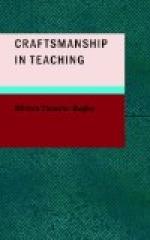I repeat that the reform movement has done excellent service in extending the recognition in education of these fundamental and inborn adaptive instincts,—play, imitation, and rhythmic repetition. It has erred when it has insisted that we could depend upon these alone, for nature has adapted man, not to the complicated conditions of our modern highly organized social life, but rather to primitive conditions. Left to themselves, these instinctive forces would take the child up to a certain point, but they would still leave him on a primitive plane. I know of one good authority on the teaching of reading who maintains that the normal child would learn to read without formal teaching if he were placed in the right environment,—an environment of books. This may be possible with some exceptional children, but even an environment reasonably replete with books does not effect this miracle in the case of certain children whom I know very well and whom I like to think of as perfectly normal. These children learned to talk by imitation and instinctive repetition. But nature has not yet gone so far as to provide the average child with spontaneous impulses that will lead him to learn to read. Reading is a much more complicated and highly organized process. And so it is with a vast number of the activities that our pupils must master.
Another increment of progress that the reform movement has given to educational practice is a recognition of the fact that we have been requiring pupils to acquire unnecessary habits, under the impression, that even if the habits were not useful, something of value was gained in their acquisition. As a result, we have passed all of our grain through the same mill, unmindful of the fact that different life activities required different types of grist. To-day we are seeing the need for carefully selecting the types of habit and skill that should be developed in all children. We are recognizing that there are many phases of the educative process that it is not well to reduce to an automatic basis. When I was in the elementary school I memorized Barnes’s History of the United States and Harper’s Geography from cover to cover. I have never greatly regretted this automatic mastery; but I have often thought that I might have memorized something rather more important, for history and geography could have been mastered just as effectively in another way.




